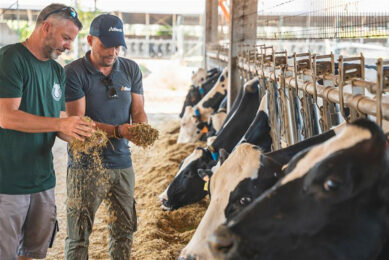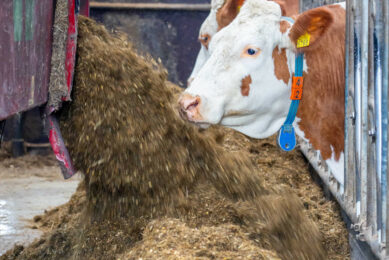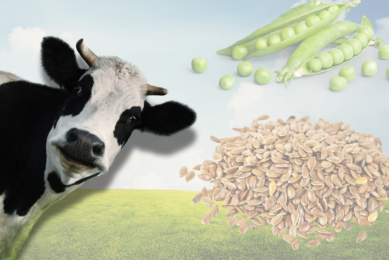1000 litres milk extra in the first lactation?

Proper targeted feeding and care of your calves in the first two months of life produces up to 1000 litres of extra milk during the first lactation. This message was spread by Sprayfo in advertisements and brochures. How does Sprayfo reach such a conclusion and what evidence does it have? Product manager Eile van der Gaast explains.
You claim that proper targeted calf rearing lead to as much as 1000 litres of extra milk in lactation. How did you get to this amount?
“A calf’s udder development can only be influenced – either positively or negatively – in the first two months of life. The key is the calf’s growth: if it’s growing strongly, udder development will be good. This was demonstrated in a trial by Brown in 2005 (Table 1). Strong growth at rearing also means better development of the mammary tissue. If growth over the first two months of life is retarded, then this lag can no longer be compensated after the third month using extra concentrates.
Additionally, a large number of trials have established the connection between growth before weaning and milk production in the first lactation. A concrete result of these studies is that one gram extra growth per day at weaning provides 6.7 litres more milk in the first lactation!”
Table 1 – Result of udder development trial conducted by Brown. |
What is needed to achieve that extra 1000 litres?
“The answer to the previous question already suggests that stronger growth is required at weaning. In the Netherlands, growth per day at weaning is 600 grams under normal conditions. In the Sprayfo Life Start trials we achieved more than 800 grams a day using an intensive milk-feeding programme. If we assume 200 grams extra growth per day x 6.7 litres extra milk production = 1340 litres extra during the first lactation, but we state 1000 litres of extra milk to be on the cautious side. So this explains Sprayfo’s motto ‘Life Start sets Life Performance’!
The extra growth is realised by focusing carefully on proper calf rearing and an intensive milk-feeding programme (Table 2). This involves not only Sprayfo, which is fed in high concentrations owing to its excellent dissolvability and digestibility, but also a suitable feeding schedule and active support for the dairy farmer. These are the core elements of the Sprayfo Life Start Concept.”
Table 2 – Different treatment factors. |
Can any dairy farmer achieve these results?
“Not everyone will manage theses extra yields, as growth may already be very healthy. However, in practice three quarters of dairy farmers will benefit from major gains. Many dairy farms already take a big leap forward simply by recalibrating the drinking machines and adapting the feeding schedule”
What are the other benefits of intensive milk-feeding, besides better udder development?
“In practice, worldwide, calves usually get far too little milk in the first few weeks. They are fed too carefully, many farmers accept that calves only recover their birth weight after 7–10 days. However, that’s too late, these calves grow more slowly over the first two weeks and are susceptible to disease. And yet the first two weeks are absolutely key to the total rearing period! After three days of colostrum, most calves should switch to calf milk replacer on day four. A supple transition and care to ensure the calf gets enough milk (think energy and protein) is crucial. Try to give your calves four litres a day of milk replacer within three days of the colostrum period, observing a mix ratio of 1 to 6 (150 g/litre). In this way, calves get the amount of energy and protein they need for growth and resistance. Towards the end of the second week, six litres of milk is the final goal. Such an approach prevents disease and growth stops and makes your calves strong. You can then maximise their genetic potential later, during the milk period.”
“Furthermore calves that had more calf milk replacers also will have a higher intake of concentrates. Quick growth stimulates the intake of concentrates, which is significant for a good rumen development. Quick growth through optimal milk supply goes hand in hand with an optimal rumen development. By a phased and slow reduction of milk supply and by not weaning too early, the growth pace will stay at the right level.”
Strong influence of feed on udder development confirmed yet again Correlation between calf’s feed intake and udder development Mammary tissue responds strongly to higher levels of nutrition Making the most of genetic potential |
Join 13,000+ subscribers
Subscribe to our newsletter to stay updated about all the need-to-know content in the dairy sector, two times a week.










